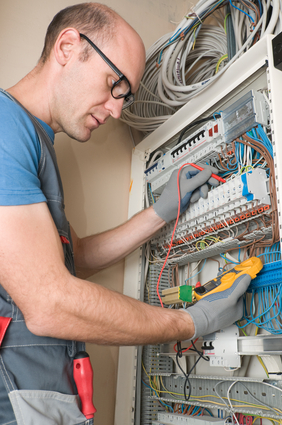
The tools an electrician uses most often will depend on the work site. It will depend on whether he or she is working as a contractor or employee involved with new construction or is working as an electrical repairperson serving homes or businesses. Regardless of workplace, basic tools will include the following:
Circuit Tester
A circuit tester determines the presence of power at an electrical outlet or between wires. The tester has a signal light to indicate current and two prongs or wires that are placed into the outlet’s openings or touched to wires.
Multimeter
Multimeters measure voltage, current and resistance between contact points. Although inexpensive analog versions are available, the best meters provide digital readouts. A zero or less than expected voltage reading indicates a broken or problem circuit. Current measurement determines power – amps – passing through a circuit; however, meters have a fused, measurable limit – usually 20 amps. A zero resistance reading indicates an open circuit.
Pliers
An electrician uses pliers to grip, twist and manipulate wires. All of these actions are required to simply attach wires to screw terminals on fuse boxes, switches or outlets. Pliers are used to braid and twist wires together before using a twist on or crimp connector. Slip-joint and side-cutting needle-nose pliers are basic types for electrical work. Six and nine-inch sizes are most common. Nine-inch pliers should be capable of heavy-duty cutting and crimping.
Wire Strippers and Wire Cutters
Notched wire strippers enable an electrician to cut through wire insulation to allow its clean and easy removal. Individual notches fit a wire size and prevent cutting the wire. A popular wire stripper is a 4-in-1 combination pliers, stripper, crimper and bolt cutter. A large crescent shaped wire cutter can cut through heavy wire and sheathing.
Screwdrivers
Screwdrivers – and nut drivers – are needed to work with various electrical wire fasteners. Screwdrivers are necessary for tightening a variety of screw terminals. In addition to the usual #1 and #2 Phillips head and various sized flat head screwdrivers, electrical work requires screwdrivers with square and star tips. Nut drivers are used to attach lugs. All-in-one drivers are available with Phillips, flat head, nut and Torx tips.
Power Drill/Driver
Whether on a construction site or in a home, installation of fixtures and outlets will require drilling. A cordless 3/8”, 18V variable drill/driver set with its assortment of drills, screw tips and nut drivers is indispensable.
Drywall Saw
To install new wiring or to access wire for repair, a drywall saw is necessary. A drywall saw uses a long, thin blade with serrations similar to a hand held ripsaw. It can cut a small hole for wires to pass through or cut out a location for an outlet.
Measuring Devices
Laser-measuring tools are now popular, but a couple of tape measures are still useful. Ten and twenty five-foot lengths that do not buckle readily are a good choice. Tapes with magnetic tips are useful for one-person measurements.
Fish Tape
In installation of wiring, a fish tape is a necessity. Fish tape is narrow, flat tape that is flexible enough to pass through curves. Wire attached to the tape can be pulled or pushed through a wall’s cavity or electrical conduit.
Featured images:
- License: Royalty Free or iStock source: depositphotos.com
These tips were brought to you on behalf of Mr. Electric of Barrie, Mr. Electric is an experienced electrician serving Barrie & surrounding areas. Visit us today!










Comments